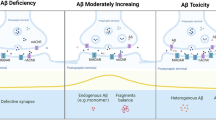Abstract
Objective
To examine whether ginsenoside Rg1 (Rg1) inhibits the high-voltage-activated calcium currents (ICa,HVA) via mitogen-activated protein kinase (MAPK) in hippocampal neurons in rat brain slices exposed to beta-amyloid peptide 25–35 (Aβ25–35).
Methods
An experimental Alzheimer disease (AD) model was prepared by exposure of rat brain slices to Aβ25–35 (10 µmol/L). After treatment with Rg1 (20 µmol/L), the ICa,HVA elicited in hippocampal neurons in these rat brain slices upon depolarization from–40 to 40 mV for 200 ms was recorded by a whole-cell patch clamp to analyze the changes in the peak current density, I–V curve, activation-V curve, and inactivation-V curve.
Results
Exposure of rat brain slices to Aβ led to a significant increase in ICa,HVA, enhancement of the voltage sensitivity of channel activation, and reduction of the voltage sensitivity of channel inactivation in neurons in the hippocampus of rat brain slices. Rg1 treatment significantly inhibited these changes. These effects of Rg1 could be effectively inhibited by the MAPK inhibitor PD98059.
Conclusion
Rg1 can inhibit Ica,HVA via MAPK in hippocampal neurons in Aβ-exposed rat brain slices.
Similar content being viewed by others
References
Luo DZ, Hou XY, Hou L, Wang MX, Xu S, Dong CF, et al. Effect of pioglitazone on altered expression of A beta metabolism-associated molecules in the brain of fructosedrinking rats, a rodent model of insulin resistance. Eur J Pharmacol 2011;664:14–19.
Tanzi RE, Moir RD, Wagner SL. Clearance of Alzheimer’s A beta peptide: the many roads to perdition. Neuron 2004;43:605–608.
Dante S, Hauss T, Dencher NA. Beta-amyloid 25 to 35 is intercalated in anionic and zwitterionic lipid membranes to different extents. Biophys J 2002;83:2610–2616.
Qi JS, Qiao JT. Amyloid beta-protein fragment 31–35 forms ion channels in membrane patches excised from rat hippocampal neurons. Neuroscience 2001;105:845–852.
Arvanitakis Z, Wilson RS, Bienias JL, Evans DA, Bennett DA. Diabetes mellitus and risk of Alzheimer disease and decline in cognitive function. Arch Neurol 2004;61:661–666.
Morales-Hernandez A, Sanchez-Martin FJ, Hortigon-Vinagre MP, Henao F, Merino JM. 2,3,7,8-Tetrachlorodibenzop-dioxin induces apoptosis by disruption of intracellular calcium homeostasis in human neuronal cell line SHSY5Y. Apoptosis 2012;17:1170–1181.
Thibault O, Hadley R, Landfield PW. Elevated postsynaptic [Ca2+]i and L-type calcium channel activity in aged hippocampal neurons: relationship to impaired synaptic plasticity. J Neurosci 2001;21:9744–9756.
Foster TC. Calcium homeostasis and modulation of synaptic plasticity in the aged brain. Aging Cell 2007;6:319–325.
Simonian NA, Coyle JT. Oxidative stress in neurodegenerative diseases. Annu Rev Pharmacol Toxicol 1996;36:83–106.
Ekinci FJ, Malik KU, Shea TB. Activation of the L voltagesensitive calcium channel by mitogen-activated protein (MAP) kinase following exposure of neuronal cells to beta-amyloid-Map kinase mediates beta-amyloid-induced neurodegeneration. J Biol Chem 1999;274:30322–30327.
Attele AS, Wu JA, Yuan CS. Ginseng pharmacology—multiple constituents and multiple actions. Biochem Pharmacol 1999;58:1685–1693.
Quan QK, Wang J, Li X, Wang Y. Ginsenoside Rg1 decreases A beta1–42 level by upregulating PPAR gamma and IDE expression in the hippocampus of a rat model of Alzheimer’s disease. Plos One 2013;8:e59155.
Fang F, Chen X, Huang T, Lue LF, Luddy JS, Yan SS. Multi-faced neuroprotective effects of ginsenoside Rg1 in an Alzheimer mouse model. Biochim Biophys Acta 2012; 822:286–292.
Wang YH, Du GH. Ginsenoside Rg1 inhibits betasecretase activity in vitro and protects against A betainduced cytotoxicity in PC12 cells. J Asian Nat Prod Res 2009;11:604–612.
Liu QA, Kou JP, Yu BY. Ginsenoside Rg1 protects against hydrogen peroxide-induced cell death in PC12 cells via inhibiting NF-kappa B activation. Neurochem Int 2011;58:119–125.
Gong L, Li S L, Li H, Zhang L. Ginsenoside Rg1 protects primary cultured rat hippocampal neurons from cell apoptosis induced by beta-amyloid protein. Pharm Biol 2011;49:501–507.
Chen YB, Zhang DP, Feng M, Wang Q, Cheng SY, Liang WX, et al. Effects of ginsenoside Rg1 on nuclear factorkappa B activity in beta amyloid protein-treated neural cells. Neural Regen Res 2009;4:590–596.
Cheng Y, Shen LH, Zhang JT. Anti-amnestic and anti-aging effects of ginsenoside Rg1 and Rb1 and its mechanism of action. Acta Pharmacol Sin 2005;26:143–149.
Mook-Jung I, Hong HS, Boo JH, Lee KH, Yun SH, Cheong MY, et al. Ginsenoside Rb1 and Rg1 improve spatial learning and increase hippocampal synaptophysin level in mice. J Neurosci Res 2001;63:509–515.
Shi YQ, Huang TW, Chen LM, Pan XD, Zhang J, Zhu YG, et al. Ginsenoside Rg1 attenuates amyloid-beta content, regulates PKA/CREB activity, and improves cognitive performance in SAMP8 mice. J Alzheimers Dis 2010;19:977–989.
Wei Y, Zhao LQ, Qi BZ, Xiao X, He L, Zhou GQ, et al. Lysophosphatidic acid increases the electrophysiological instability of adult rabbit ventricular myocardium by augmenting L-type calcium current. PLoS One 2012;7:e45862.
Lin H, Bhatia R, Lal R. Amyloid beta protein forms ion channels: implications for Alzheimer’s disease pathophysiology. FASEB J 2001;16:2433–2444.
Lin RY, Deng TX, Zhang JF, Wang QW. Progress of the relationship between Ca2+ dysregulation and Alzheimer’s disease development. Chin Bull Life Sci (Chin) 2012;24:297–303.
Shea TB, Prabhakar S, Ekinci FJ. Beta-amyloid and ionophore A23187 evoke Tau hyperphosphorylation by distinct intracellular pathways: differential involvement of the calpain protein kinase C system. J Neurosci Res 1997;49:759–768.
Ueda K, Shinohara S, Yagami T, Asakura K, Kawasaki K. Amyloid beta protein potentiates Ca2+ influx through L-type voltage-sensitive Ca2+ channels: a possible involvement of free radicals. J Neurochem 1997;68:265–271.
Chen L, Liu CJ, Tang M, Li A, Hu XW, Zhou Y, et al. Action of beta-amyloid peptide 1–40 on I (HVA) and its modulation by ginkgolide B. Acta Physiol Sin 2006;58:14–20.
Author information
Authors and Affiliations
Corresponding author
Additional information
Supported by the Tackle Key Problems in Science and Technology Foundation of Shaanxi Province, China [No. 2007K16-07(5)]; and the Program of Administration of Traditional Chinese Medicine of Shaanxi Province, China (No. 2005030)
Rights and permissions
About this article
Cite this article
Quan, Qk., Li, X., Yuan, Hf. et al. Ginsenoside Rg1 inhibits high-voltage-activated calcium channel currents in hippocampal neurons of beta-amyloid peptide-exposed rat brain slices. Chin. J. Integr. Med. (2016). https://doi.org/10.1007/s11655-015-2301-4
Received:
Published:
DOI: https://doi.org/10.1007/s11655-015-2301-4




